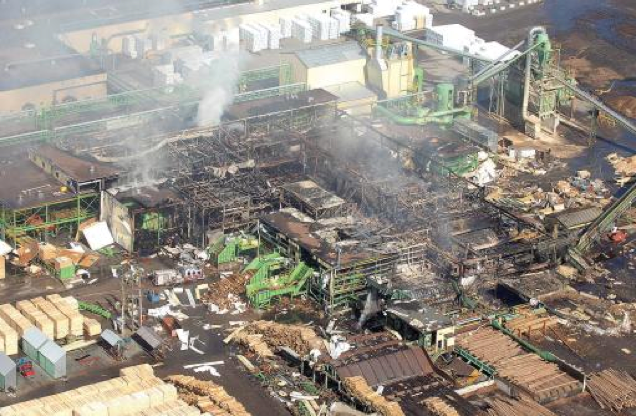The president of the Steelworkers local in Kamloops says the union is demanding an emergency meeting with all the employers in its Interior divisions in the wake of the Prince George mill explosion.
"We're very concerned," said Marty Gibbons.
Two deadly explosions in northern British Columbia sawmills in recent months have prompted a sweeping review of safety in all sawmills in the province and raised concerns about whether the extremely fine dust from pine-beetle ravaged timber is part of the problem.
"It was quite unbelievable for the first explosion," said Gibbons, of the January incident in Burns Lake. "The second one, the investigation's barely begun, but as a union we're going to err on the side of caution and seriously consider that dust played a very key role in those disasters."
Shift supervisor Alan Little, 43, died Tuesday after being rushed to hospital following the massive blast at the Lakeland sawmill in Prince George on Monday night.
The explosion caused a ferocious fire and sent 10 others to hospital with serious or critical injuries.
The explosion at the Babine Forest Products in Burns Lake killed two and 18 others were sent to hospital.
Gibbons said although findings on the Burns Lake explosion are still months away, it's indicative that the industry immediately responded by increasing dust control with new ventilation and beefed-up cleaning measures.
"So the industry is definitely aware and concerned," he said.
Steve Hunt, United Steelworkers Western Canada director, said Tuesday there's obviously a serious problem with the province's sawmilling industry.
"Obviously something is causing these mills to explode and to speculate is really, really dangerous… I don't think either the RCMP or the (WorkSafe B.C.) anticipated another blast. And it may not be related, but to me, there's enough of a coincidence here to take strong action immediately to prevent any similar occurrences from happening."
Labour Minister Margaret MacDiarmid said she will send an order to all sawmills in the province, "asking them, telling them, instructing them to inspect from top to bottom their mills."
"There's a common factor here and we're all aware of it and it's sawdust. So although we don't know what caused the initial fires or explosions, we know that sawdust may be factor."
Last week, WorkSafe B.C. said it is still investigating the Burns Lake blast and a report could be months away.
Independent Cariboo-North MLA Bob Simpson said he wondered if the pine beetle that has caused so much damage to the B.C. forest industry is also responsible for heightened safety hazards.
"There is growing anecdotal evidence that (mountain pine beetle-killed) logs may be producing combustible materials that interior sawmills were not designed to address," Simpson said in a statement.
"It is highly unusual to have two mills explode and burn down like this. For that reason, we should take precautions to carefully examine if something substantially different is occurring as a result of processing these… logs."
Simpson noted that when dry, beetle-killed logs started to blow apart in the saws inside sawmills in the province's Interior, steps were taken to put up safety nets to protect employees.
But he said the fine dust and dry resin coming off the logs should now be looked at as a heightened safety hazard.
Sawdust is always seen as a potential culprit in mill explosions.
George Astrakianakis, an assistant professor at the University of British Columbia specializing in occupational and environmental health, said dust with a spark and oxygen create an equation that always equals fire.



